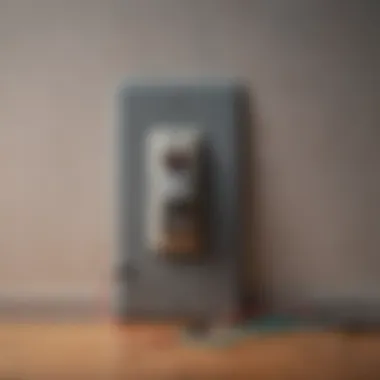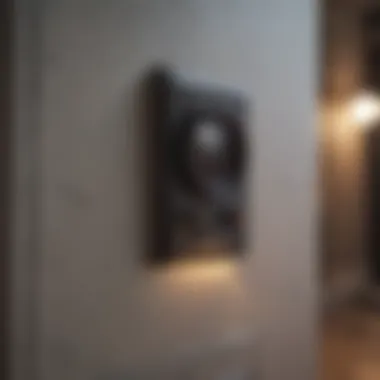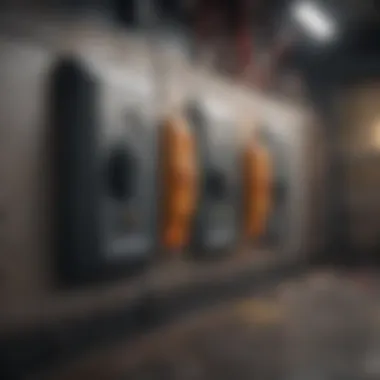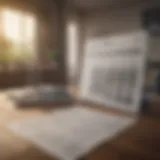Understanding Electric Switch Tripping: Causes and Solutions


Intro
Electric switch tripping is a common inconvenience that many homeowners encounter. While it may seem like a minor annoyance, understanding the underlying causes is essential to maintaining a safe and functional electrical system in your home. Circuit breakers are designed to protect your home from electrical overloads, short circuits, and ground faults. When they trip, it signals a potential problem that should not be ignored.
In this article, we will thoroughly examine the mechanics behind electric switch tripping. We will identify the factors that contribute to these disruptions, practical troubleshooting methods, and effective prevention strategies. The goal is to provide property owners and real estate enthusiasts with a comprehensive understanding of electrical safety, ultimately enhancing the functionality of home electrical systems.
Armed with this knowledge, homeowners can engage more intelligently with their electrical systems, understanding how to address issues before they escalate.
Causes of Electric Switch Tripping
Electrical systems in homes are complex. Common causes for circuit breakers tripping include excessive electrical load, short circuits, and ground faults. Here are some details on each:
- Excessive Load: This occurs when too many devices are drawing power from a single circuit. For instance, plugging multiple high-wattage appliances into one outlet can easily overwhelm the circuit.
- Short Circuits: A short circuit happens when a hot wire touches a neutral wire or when a wire is exposed. This draws a large amount of current and may cause the breaker to trip.
- Ground Faults: These occur when a hot wire comes into contact with a ground wire or an object that is grounded. This can happen in wet areas, like bathrooms or kitchens, posing safety risks.
Solutions to Electric Switch Tripping
When faced with circuit tripping, prompt action is essential. Here are effective steps to take:
- Identify the Cause: Start by determining which appliance or device leads to the tripping. Unplug devices and see if the breaker resets.
- Check the Circuit: Inspect the circuit for signs of damage or wear. Look for frayed wires or faulty connections.
- Reduce Load: Avoid overloading circuits by spreading out your devices across multiple outlets. You might need to upgrade your electrical system if necessary.
- Consult a Professional: If you cannot locate the source of the problem, it may be wise to contact an electrician. They can analyze and address complex issues effectively.
Prevention Strategies
Preventing electric switch tripping involves being proactive. Consider these strategies:
- Regular Inspections: Schedule routine electrical system checks to ensure everything is functioning correctly and to catch issues early.
- Upgrade Circuit Breakers: Invest in modern breakers that offer better protection and prevent nuisance tripping.
- Educate Household Members: Teach everyone in your home about safe electrical practices, including the importance of not overloading outlets.
"Understanding the functionality of your electrical system is crucial for preventing safety issues and ensuring a stable living environment."
In summary, knowing the causes and solutions for electric switch tripping helps homeowners minimize risks and enhance their electrical safety. Educating oneself on these matters can lead to a more reliable and secure living space. The next sections will delve deeper into practical applications and enhancements in electrical systems for homes.
Preamble to Electric Switch Tripping
Electric switch tripping is a crucial topic that affects not only residential areas but also commercial properties. Understanding this phenomenon is essential for maintaining the safety and functionality of electrical systems. When switches trip, it can interrupt daily activities and potentially lead to hazardous situations. This article delves deeply into the mechanics of electric switches, the reasons they trip, and how to troubleshoot and prevent such events.
Definition and Purpose of Electric Switches
Electric switches serve a vital role in the management of electrical circuits. Their main function is to control the flow of electricity to appliances and devices. When an abnormality occurs within the system, such as excessive current, the switch will trip, effectively cutting off power. This protective measure helps to prevent damage to electrical equipment and ensures safety within the household or business environment.
The importance of electric switches extends beyond mere functionality. They play a significant part in energy efficiency, allowing users to manage power consumption effectively. By preventing overloads and potential electrical fires, switches also uphold safety standards in any property. Without a proper understanding of how these switches operate and the reasons they might trip, individuals may find themselves ill-prepared for preventing electrical mishaps.
Types of Electric Switches
Electric switches come in various forms, each tailored to specific applications. The two primary types are manual switches and automatic switches. Manual switches require user intervention for operation and are commonly found in household light fixtures. Automatic switches, on the other hand, respond to specific conditions, such as motion or light levels, to manage electrical flow without direct user input.
- Manual Switches: These include toggle switches and rocker switches, which are very common in everyday applications.
- Automatic Switches: Examples are motion sensors and timers, which enhance convenience and save energy by controlling power based on environmental conditions.
- Circuit Breakers: A specialized type of automatic switch, these are designed to protect electrical circuits by interrupting power flow during overloads or short circuits.
Understanding the different types of these switches is integral. It enables property owners to select the appropriate type according to their specific needs, improving both safety and efficiency.
The Mechanism of Circuit Breakers
Understanding how circuit breakers function is vital. These devices protect electrical systems by interrupting the flow of current during faults or overloads. Their proper operation ensures safety and prevents potential damage to household appliances and electrical infrastructures. Knowing the mechanics behind circuit breakers helps property owners maintain a reliable and safe electrical environment.
How Circuit Breakers Function


Circuit breakers detect faults in electrical circuits, such as overloads or short circuits. They consist of mechanical and thermal components. When electricity flows normally, the breaker remains closed. If the current exceeds a certain threshold, the breaker opens (trips), stopping the flow of electricity. This prevents overheating and potential fire hazards.
Key Functions of Circuit Breakers:
- Overload Protection: Breakers are designed to trip when excessive current flows, preventing wires from overheating.
- Short Circuit Protection: They quickly disconnect power during short circuits, ensuring immediate prevention of fire risks or equipment damage.
- Reset Mechanism: After addressing the cause of tripping, most breakers can be reset easily, restoring power without needing replacements.
In addition, circuit breakers can offer manual control, allowing users to turn off power when necessary, adding another layer of safety during maintenance.
Different Classes of Circuit Breakers
There are various classes of circuit breakers, each suited for specific applications and environments. The primary types include:
- Miniature Circuit Breakers (MCB): Safeguard against overloads and minor short circuits. Common in residential settings.
- Residual Current Circuit Breakers (RCCB): Protect against ground faults by detecting imbalances in current. Essential for safety in wet areas like bathrooms.
- Molded Case Circuit Breakers (MCCB): Manage moderate to high currents, often used in commercial applications.
- Air Circuit Breakers (ACB): Handle large electrical currents, typically found in industrial settings.
Selecting the right type of circuit breaker is crucial. It depends on the specific needs of the electrical system and the potential risks involved. Regular inspection and updating old breakers can also enhance the overall safety and efficiency of electrical systems.
Common Reasons for Electric Switch Tripping
Understanding the common reasons for electric switch tripping is essential for property owners and anyone interacting with electrical systems. This knowledge helps in identifying issues before they escalate into more significant problems. Each reason for tripping reveals something about the condition of your electrical system and can guide appropriate responses. Evaluating the underlying causes not only improves safety but also enhances the longevity of electrical equipment.
Overloads: Understanding Electrical Load
Overloading occurs when the current flowing through the circuit exceeds its designed capacity. Each circuit breaker has a specific rating, and when too many devices pull power, tripping may happen. For instance, running multiple high-wattage appliances simultaneously, like toasters, microwaves, and heaters, can easily exceed the limit.
Common signs of overload include:
- Frequent tripping of the circuit breaker
- Dimming or flickering lights when high-power devices start
- Warm or hot outlets or breaker panels
To prevent overloads, it's crucial to distribute electrical load effectively. Understanding the wattage of devices and balancing usage across different circuits can minimize risks. Educating oneself about the safe operation of electrical devices is another effective strategy to avoid overloading.
Short Circuits: Causes and Consequences
Short circuits occur when a live wire touches a neutral wire or other conductive materials. This may create a direct path for the electrical current, which can be dangerous. Common causes of short circuits include damaged wires, loose connections, and defective appliances.
The immediate consequences often involve tripped breakers or blown fuses. Additionally, a short circuit can lead to serious safety hazards like electrical fires or equipment damage. Therefore, recognizing the signs is vital. Look for:
- Burn marks around outlets or plugs
- Popping sounds when appliances are used
- Sparking or crackling noises
To address short circuits, regularly inspect cords and appliances, ensuring no damage exists. Should a short circuit be suspected, disconnect the equipment immediately and seek professional help if needed.
Ground Faults and Residual Current Device (RCD) Activation
Ground faults happen when electricity travels outside its intended path. This often occurs when a live wire contacts the ground or a grounded object. Ground Fault Circuit Interrupters (GFCIs) can detect these faults and cut off power to prevent shock hazards.
RCDs are designed to protect against electric shocks and faults by tripping when they detect an imbalance in electrical currents. Common causes of RCD activation include:
- Wet appliances or environments, as water conducts electricity
- Damaged insulation on wires
- Faulty appliances that leak current
To prevent unnecessary RCD activation, utilizing GFCIs in wet locations is useful. Regular maintenance checks of appliances and circuitry can also mitigate risks. Educating yourself on the operation of RCDs contributes to better overall safety in domestic settings.
Frequent electric switch tripping indicates potential issues that require timely intervention.
Understanding the reasons behind electric switch tripping is vital for maintaining electrical safety. By knowing how to identify signs of overloads, short circuits, and ground faults, property owners can act preemptively. This leads to a safer and more secure environment for all household members.
Troubleshooting a Tripped Switch


Troubleshooting a tripped switch is a crucial aspect of maintaining electrical systems in any residential setting. Being able to identify and address the root causes of tripping switches can contribute significantly to the overall safety and efficiency of household electrical installations. This section aims to illuminate specific elements involved in the troubleshooting process, benefits of prompt actions, and considerations one must keep in mind when dealing with electrical issues.
Initial Steps to Identify the Issue
The first step in troubleshooting a tripped switch involves understanding the nature of the problem. Begin by assessing which circuit breaker has tripped. This simple act can save time and pinpoint the affected area. After restoring power, one should note whether the switch quickly trips again. If it does, then this indicates a persistent issue that requires further investigation.
It's advisable to turn off all connected appliances and devices prior to resetting the circuit breaker. This step helps to isolate the problem, as it reduces the load on the circuit. After resetting, gradually turn on devices one at a time to identify the specific appliance causing the issue. Keeping this process methodical will help in determining whether the problem is with a particular device or with the electrical circuit itself.
Assessing Appliances and Devices
Once the issue is identified, auditing the appliances and devices connected to the circuit is essential. Check each appliance for any visible damage such as frayed cords or burnt components. Devices that are known for higher voltage requirements, like space heaters or air conditioners, should be examined closely as they are common culprits in tripping switches.
If everything appears normal on the surface, consider testing the devices with a multimeter. This can measure electrical output and determine if they are functioning within safe parameters.
Key points to evaluate:
- Look for unusual sounds or smells from appliances
- Check for signs of overheating
- Assess whether the devices are rated for the circuit's capacity
Inspecting Wiring for Damage
If the appliances are deemed safe, it is time to inspect the wiring for damage. Unstable wiring poses significant risks and can lead to hazardous situations, such as electrical fires. Examine all visible wiring for wear, insulation damage, or corrosion. Pay special attention to junction boxes or outlets that show signs of melting or scorch marks, as they can indicate larger issues in the electrical system.
If you are unable to visually inspect your wiring fully or feel uncertain about what to look for, it may be prudent to solicit the help of a professional electrician. Their expertise will provide peace of mind and ensure that any hidden issues are addressed promptly.
Remember: Regular inspection and attention to detail in both appliances and wiring can significantly reduce the likelihood of tripped switches and enhance overall electrical safety.
Preventive Measures to Avoid Tripping
The discussion of electric switch tripping extends beyond just identifying causes and troubleshooting methods. An important aspect is implementing preventive measures to avoid nuisance tripping and ensure electrical systems are safe and efficient. Preventive strategies not only protect the electrical infrastructure but also enhance the longevity of electrical devices, ultimately saving costs in repairs and replacements. Additionally, adopting these measures contributes to overall safety for occupants of a property.
Regular Maintenance of Electrical Systems
Maintaining electrical systems involves routine inspections and servicing. It is vital for identifying potential issues before they escalate. Basic tasks include checking circuit panels for any signs of wear or overheating. This can involve tightening loose connections or replacing any components showing signs of damage. Regular evaluations of breakers and switches will help ensure that all components function optimally, thus reducing the likelihood of unexpected tripping.
- Testing Circuit Breakers: Each breaker should be tested regularly to confirm it is functioning correctly. One can do this by switching off and on again to observe if they trip normally.
- Inspections by Professionals: Sometimes, professional inspections can catch issues that a layperson might miss. Electricians can perform thorough checkups on the entire electrical system and provide necessary repairs or upgrades.
Upgrading Outdated Circuit Breakers
Older circuit breakers may not handle the electrical load of today’s technology. When upgrading, it is prudent to select modern circuit breakers with advanced features. Newer models may incorporate features like smart technology or enhanced safety mechanisms that can provide more reliable protection.
- Considerations for Upgrade: Think about how many circuits are in the home and their current load demands. This assessment can highlight needs for additional or upgraded breakers.
- Investing in Quality Options: Investing in quality brands such as Square D or Eaton can be beneficial, as they often provide greater reliability and efficiency.
This proactive approach ensures that the electrical systems are designed to handle current demands and reduce the risk of frequent tripping.
Distribution of Electrical Load
Proper distribution of electrical load can significantly minimize the risk of overload situations that lead to tripping. It is essential to evaluate how devices are connected across various circuits.
- Avoid Overloading Circuits: Identify high-demand appliances and distribute them effectively. Ensure that heavy devices, such as air conditioners or refrigerators, do not share circuits with smaller devices.
- Utilize Plug Strips Wisely: Avoid using multiple plug strips for many devices in a single outlet. Instead, distribute the load across various circuit options to alleviate stress on any single circuit breaker.
"Preventive actions are more cost-effective than emergency repairs that frequent failures might invoke."
Being vigilant about these aspects contributes to a safer living environment.
Impact of Frequent Tripping


The issue of electric switch tripping is critical to understand due to its potential implications on safety and economics. When switches trip frequently, it can signify underlying issues that could compromise safety. The relationship between tripping and electrical system integrity is complicated but essential to address.
Regular tripping may indicate overloaded circuits, damaged appliances, or deteriorating wiring. Such problems can escalate if not addressed immediately. This escalation often leads to risks like electrical fires or equipment damage, resulting in significant financial burden.
Potential Risks to Safety
Frequent tripping can expose homes to serious safety risks. The most immediate concern is the risk of electrical fires, which can occur when circuits are overloaded. An overloaded circuit may heat to levels that ignite surrounding materials. This hazard is heightened when the electrical system is poorly maintained or when devices are phased out without proper upgrades.
Moreover, tripping can create safety issues when it disrupts critical systems. For example, if a circuit controlling heating or cooling fails during extreme weather, it can lead to unsafe conditions.
Key safety concerns include:
- Overheating: Prolonged current can lead to overheating, damaging equipment and creating fire hazards.
- Equipment Failure: Frequent tripping can cause significant wear on electrical tools and appliances, shortening their lifespan.
- Personal Safety: If tripping occurs in high-traffic areas, such risks can translate to physical accidents such as falls when light or power fails unexpectedly.
Economic Implications of Electrical Failures
The economic impact of frequent tripping is noteworthy. Every incident can lead to costly repairs and increased utility bills. When switches trip continuously, they result in downtime for appliances, causing inconvenience and further expenses in replacements.
Signs of underlying electrical issues often necessitate additional investments for inspection and repair. Consequential costs may include:
- Replacement Costs: Damaged equipment incurs replacement costs, which can accumulate quickly.
- Utility Costs: Increased electricity usage due to unstable breakdowns can raise monthly expenses.
- Insurance Expenses: Frequent failures may lead to higher home insurance premiums as the perceived risk increases.
In summary, understanding the impact of frequent tripping is paramount not only for safety but also for economic prudence. Close attention to these issues can result in improved safety and financial savings for homeowners. It is essential to take action when faced with frequent tripping to prevent larger problems from developing that can have lasting effects on both personal and financial well-being.
When to Call a Professional Electrician
Knowing when to involve a professional electrician can significantly impact the safety and functionality of your electrical systems. Homeowners often try to resolve electrical issues themselves, but some situations require a trained eye and expert knowledge. Seeking professional help can prevent further damage to your property and ensure compliance with safety standards.
Identifying Complex Electrical Issues
Identifying complex electrical issues can be daunting. Many signs indicate that a problem extends beyond mere inconvenience. If you notice any of the following, it may be time to contact a professional:
- Frequent tripping of circuit breakers: If a switch trips repeatedly, it indicates an underlying problem. General overloads or a faulty device causing the trips may not be completely resolved without a professional assessment.
- Burning smells or sizzling noises: These can be signs of severe electrical faults, such as damaged wires. Such issues should not be ignored.
- Visible damage to wiring: Frayed cables or scorch marks around outlets are clear signals that call for expert intervention.
- Outdated systems: If your home has not undergone electrical updates in decades, you might face hidden risks like insufficient capacity to handle modern appliances.
Many of these issues require specialized diagnostic equipment and experience to address safely. Trying to sort them out yourself often leads to safety hazards or further complications.
The Role of Professional Inspections
Professional inspections play a crucial role in maintaining electrical safety. Regular assessments help identify and rectify potential problems before they escalate into dangerous situations. When a professional examines your electrical system, they typically perform the following:
- Thorough Visual Inspection: Experts look for signs of wear, outdated components, or hazards within your electrical system.
- Testing: Technicians use electrical meters to measure voltage, amperage, and resistance, providing insights into the performance of your systems.
- Compliance Check: A professional ensures your electrical installation meets local codes and safety standards.
- Expert Recommendations: After diagnosing the system, electricians recommend necessary upgrades or repairs.
Regular professional inspections can save money in the long run. They often catch issues before they cause costly damage.
From these activities, it becomes clear that the value of professional inspections extends beyond immediate fixes. They support long-term safety, efficiency, and reliability for any electrical system. Ignoring these tasks can lead to escalating problems, more severe safety risks, and higher repair costs.
Finale
Electric switch tripping is a fundamental concept in managing residential electrical systems. Understanding the intricacies of this topic is paramount for anyone who owns a home or is responsible for maintaining electrical installations. The conclusion of this article serves as a crucial reminder of the significance of recognizing the causes and effects of electric switch tripping.
Summary of Key Points
- Electric switch tripping often occurs due to reasons like overloads, short circuits, and ground faults. Being aware of these helps in early identification.
- Troubleshooting involves systematic checks of appliances, wiring, and overall system integrity to isolate issues effectively.
- Preventive measures such as regular system maintenance and load distribution can significantly reduce occurrences.
- Recognizing when to consult a professional can avert dangerous situations.
This summary encapsulates the main arguments presented throughout the article. Knowledge of electric switch tripping not only enhances safety but also extends the lifespan of electrical systems, preventing costly repairs and dangerous accidents.
Final Thoughts on Electrical Safety
Maintaining electrical safety is crucial in any residential setting. Switched circuits are designed to protect your home from electrical fires and device damage by tripping under dangerous conditions. However, frequent tripping may point to underlying issues that require immediate attention. The benefits of a clear understanding of electrical systems cannot be overstated. After all, a sound knowledge base leads to better decisions regarding maintenance and upgrades.
In summary, acknowledging the signs and knowing how to address them fosters a safer home environment. Never underestimate the importance of vigilance when dealing with electricity, as proactive measures make a significant difference in safety. Remember, a well-informed homeowner is the best defense against electrical issues.



